NieR and Back Again
Returning to Taro Yoko’s dreamland
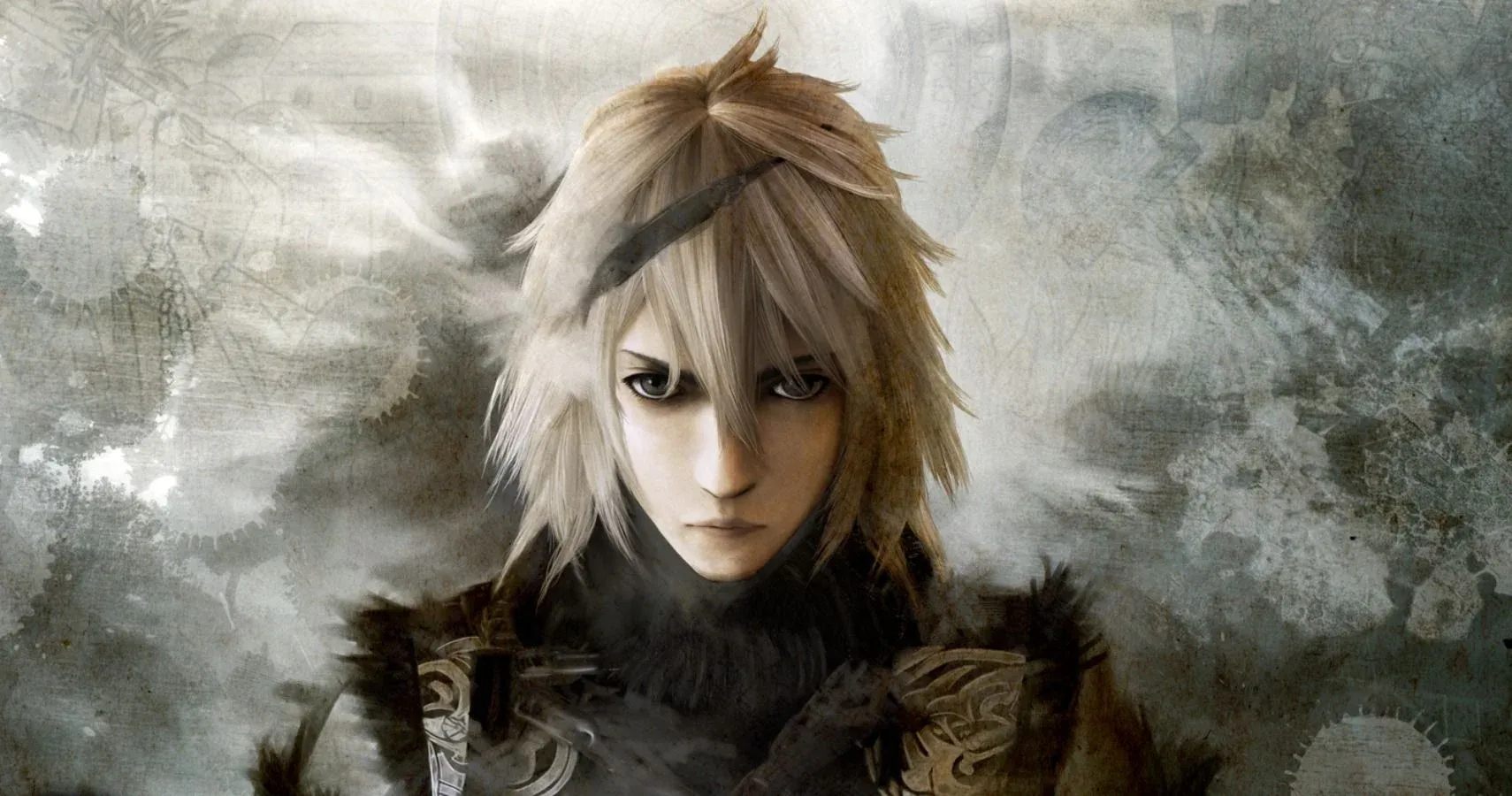

Over ten years ago — after downing consecutive energy drinks during a late-night gaming binge on my weekend away from work and college — I finished Ending D in NieR. I watched, transfixed, as Nier chose to sacrifice the very fabric of his existence in exchange for Kainé’s life, prompted by a sinister binary option. Before his selfless act could be made the game assailed me with an absurd and infamous ask:
If you choose this option, all of your save data will be erased. Are you sure about this?
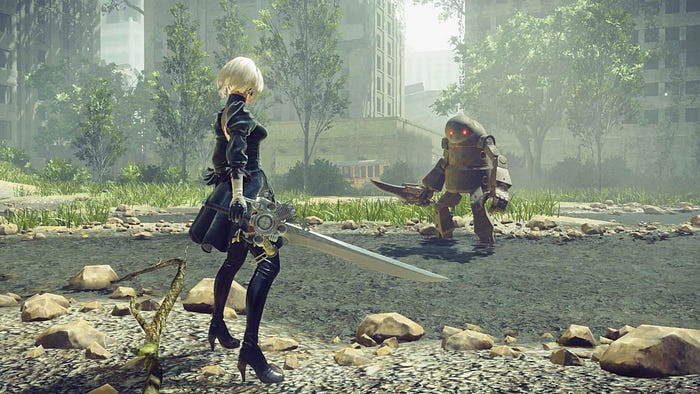
I paused a moment, unsure of what the game was asking me. Delete my data? It hadn’t been a simple thing to reach that point — in order to see Ending D, the game requests a few things from the player: play through the game multiple times, acquire every weapon, and choose the correct narrative options. After all of this — including the heart-wrenching moments leading up to the ending — the game demands everything of you.
Again, and finally, the game prompted me:
Are you really, really, sure about this?
I watched, both awestruck and horrified, as the game systematically showed the deletion of all my hard work. I watched as menu after menu, my items, weapons, and quests were permanently erased.
NieR was an unusual experience, its narrative weight cemented by the oblivion that I had been made to choose. What I didn’t know at the time was that the game’s own real oblivion had been something reflected in its real-life history — it teetered, for a long time, on being forgotten.
Against countless struggles, NieR refuses to be erased.
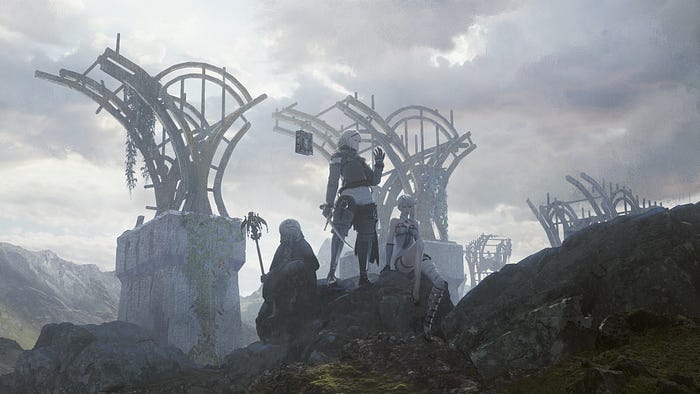
What is NieR?
What existed as a cult classic for years has recently entered the limelight. NieR: Automata exceeded all sales expectations and has become one of the most critically lauded games of the past five years. Now, after a decade in obscurity, NieR is a series at the forefront of the action RPG genre.
With NieR Replicant ver.1.22474487139…, the improbable is happening. In only a few months, we will all be playing a reimagining of the doomed cult classic, NieR Replicant. How did NieR — once a commercial failure for Square Enix — go from niche Playstation 3 outlier to one of their most popular series in just ten years?

Kainé: Weiss, you dumbass! Start making sense, you rotten book, or you’re gonna be sorry! Maybe I’ll rip your pages out, one-by-one! Or maybe I’ll put you in the goddamn furnace! How can someone with such a big, smart brain get hypnotized like a little bitch, huh?! “Oh, Shadowlord! I love you, Shadowlord! Come over here and give Weiss a big sloppy kiss, Shadowlord!” Now pull your head out of your goddamn ass and start fucking helping us!
Ashen snow falls against a sickly green sky as a soundtrack of haunting melodies and surreal vocals rises and falls. We are in a ruined city, devoid of life, devoid of kindness. Despite the falling snow, it is the summer of 2049. In a ruined store, an old man sleeps clutching a length of metal pipe, a book at his feet. As he mutters himself awake, the old man is suddenly attacked by dark, ethereal creatures. Though disadvantaged as he is, he fights back. He has a daughter to protect.
NieR is, ultimately, about personal salvation.
The storyline of the NieR games takes place across thousands of years and extends into different possible endings and player choices. Disturbingly relatable in today’s world, the games are rooted in a disease that infects humans and wreaks havoc on the remaining members of society. The solution is a complicated one, a path of gestalts and replicants, of androids and magic. While NieR and NieR: Automata are related mostly through concept, they share a common narrative purpose and structure.
Despite the series being its own, unique entity, the existence of NieR is actually built upon the bones of Drakengard. NieR (known as NieR Gestalt and NieR Replicant in Japan, and NIER in the United States) spins off of Drakengard as a result of its bizarre Ending E, where the heroes of that game cross the parallel dimensions separating their world. The outcome of their fight has great costs, and the Tokyo of 2003 is irrevocably changed. The world of NieR is not one of expected coherence, but of emotional reaction.
As one magical reality infects a non-magical one, this act of accidental violence births Taro Yoko’s cerebral — and once polarizing — masterwork.

Gestalt and Replicant
Taro Yoko, the infamous and eccentric designer of NieR and Drakengard, is known for his unconventional narrative choices. The Drakengard series — while not one of Square’s most well-known franchises — is a bizarre fusion of dark fantasy, science fiction, and surrealism. When it came time to develop a new series, after what was viewed by the parent company as a series of budget and sales failures, Yoko could not be deterred from his vision.
Global sales for NieR did not impress Square. As of 2019, the sales of NIER, NieR Replicant, and NieR Gestalt barely total 500,000 units. According to Yoko, “…we weren’t really in the red, but it wasn’t exactly a success either.” After ten years of development, Cavia would become absorbed into AQ interactive — and NieR would be their final game. Taro Yoko went on to work at Square Enix with a few former members of the defunct studio, where he was given another chance that birthed Drakengard 3. The game received modest success and mixed reviews. Yoko would continue his mixture of dark, humanist tones, and many aspects of NieR would show themselves in the narrative, despite its cold overtones and dark fantasy nature.
“I only directed the first Drakengard title but Square Enix had told me “create a game like Dynasty Warriors with a medieval setting. And, include dragons while you’re at it.” I remember thinking “there’s no way we can win against the Warriors series by just following suit” as I developed the game.
“At the time, Square Enix was not particularly interested in the story, so I did whatever I felt like doing. I have fond memories of getting many complaints from them after the fact. Well, they aren’t really ‘fond’ memories…Yep.” (via Forbes)
Despite a small increase in budget over their previous titles, Yoko’s development team again received criticism for bland world designs, poor controls, choppy performance, and worrisome gameplay aspects.
At the close of 2014, Taro Yoko was once again out of a job.
My New Year Resolution for 2014.
I know you have to work hard this year. Going life is crazy difficult.
Now, Drag-on Dragoon 3 is released in Japan. I have no plan for next
year because I will be no-job person. But I hope you will be happy in
the next year. bye.
For a time, it seemed as though NieR would remain a cult classic, a peculiar one-off doomed by a small budget that existed against Square’s more titanic Final Fantasy XIII. While momentarily removed of his curious vision, the world was not yet done with Yoko.
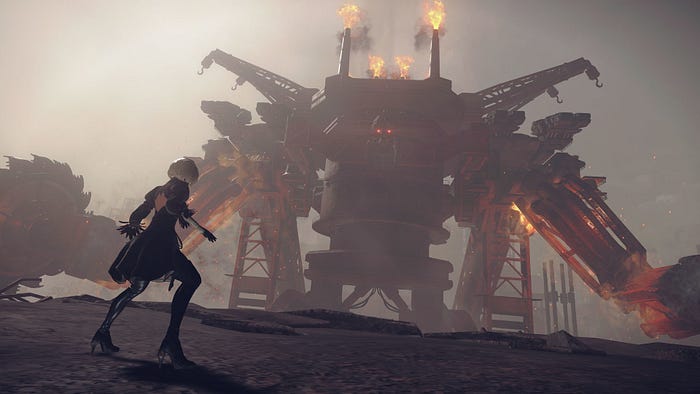
The Meaning of Killing
Taro Yoko regularly explores complex themes in his games — chief among them the desire for players to kill things or stand above others. In this interview from 2014, Yoko discusses the “invisible walls” of game development that affect or prevent certain kinds of experiences from existing in the sphere of gaming. He gives the example of an emotionally packed experience that might last only three minutes would not be well-received by the audience at a budgetary price tag of $60, even if it was an artistic masterpiece. He is endlessly fascinated with the exploration of violence as a narrative device, and how gamers have come to expect a certain amount of that violence in their games in order for the experiences to be memorable or motivating.
While video games often rally us with achievements for killing a set amount of enemies and reward us for our brutality, Yoko regards these concepts as cold, strange, and removed from humanity. These comments might come off as strange considering that he’s the developer of action RPGs that regularly feature dozens of on-screen enemies to kill at once, but similar to Hideo Kojima’s philosophy of deconstruction via gameplay, Yoko’s philosophical ideas are presented through subverting expectations. He rationalizes the behaviors of the player through the actions of each character, and one of the reasons that so many of the characters throughout NieR resolve their personal issues through violence is that it makes it easier for the player to explore outwardly inhumane concepts in a humane way.
“If there is one theme that maybe comes back again and again, in all of the works that I make, it probably is that relationship of how people see and relate to killing.”
Despite the grand, sweeping narrative arcs present in his games and the unified concepts that exist throughout the massive scope of NieR and Drakengard’s lore, Taro Yoko is a creator who seems to abhor consistency. There is a thread of identity and philosophy that unites each of these games, and at once the framework is undone by the intentional lack of clarity across multiple timelines, characters, dimensions, and possible endings. Yoko seems less interested in the cohesion of the games and more interested in how the games make you feel. Outside of the bloodshed and destruction, it is the quiet moments that are most remembered in his games, whether it’s the robots reenacting Shakespeare in Nier: Automata or Kainé and Emil’s tender, familial conversations. The actual gameplay are a placating gesture to the idea of gaming as a whole — they’re simply vessels for the narrative.
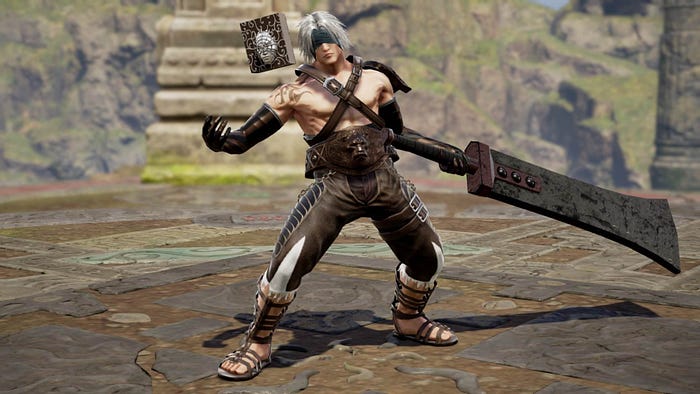
Identity Through Art
Taro Yoko is known across the internet for more than just his video games — his live persona is as strange and eccentric as the games he makes. Yoko has long questioned his own identity and prefers to present himself at fan events and interviews by wearing an Emil head or operating a sock puppet. His works are a deep, internalized reflection of who he is and how he views the world, and similar to other game designers with singular presentations he is extremely talented with keeping his teams focused on his visions.
“If anything, I could just be called ‘01’ and I’d be happy with that.” (In response to being asked by what name people should refer to him as.)
Yoko is a developer who hides in plain sight. His obsessive design philosophies often clash with his working sensibilities, and during the development of Nier: Automata he ended up living away from his family and sleeping at the studio (the game was nearly cancelled because Taro Yoko hates waking up early). While Automata carried many of the same elements as his previous entries, he relinquished the overall development and gameplay choices to Platinum Games and his young staff. Outside of the narrative, Taro views gaming as a vehicle for both player and developer intention:
“In order to develop this game, I had temporarily stationed myself in Osaka (where Platinum Games is located), away from my family. I reign over the team as the director but I’m actually just drinking beer and loafing around. So, the young staff there had created the game in its entirety.” (via Forbes)
Identity is the core component of the NieR narrative. The search for meaning is so indelibly linked to the forward momentum of both NieR and NieR: Automata that after stripping its narrative of living humans, it is not bereft of humanity. The clash between the androids, aliens and robots created some of the most philosophical moments in any game in recent memory, and littered the narrative with political philosophy, capitalist deconstructionism, the importance of unions, the dangers of the military, art in a vacuum, internalized trauma, and ultimately the search for happiness and meaning. The inclusion of names like Marx, Engels, Pascal, Adam, Eve, and more are built on the framework of identity and exist to push the player past comfort and into the further exploration of its humanist themes.
NieR: Automata felt like much more than the unexpected sequel to the 2010 cult classic; it felt like the true surge of Yoko exploring his most fascinating themes.
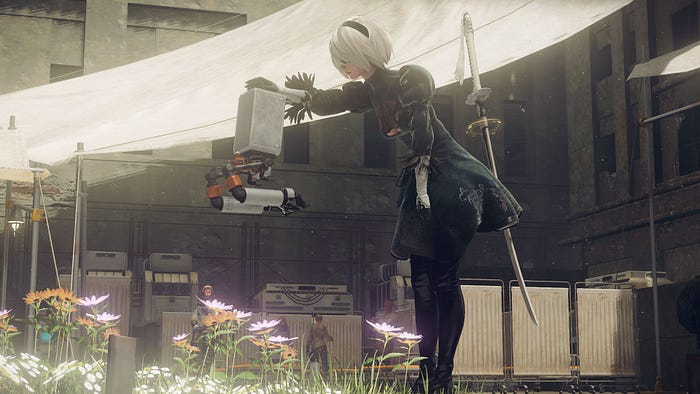
A Mad, Mad World
After years of turmoil, a bond forged between two unlikely companies. Platinum Games’ freelance development of the next NieR property did more than legitimize the niche series; it also saved Platinum from bankruptcy. Not only would NieR: Automata go on to sell over two million copies (a bonafide hit!), it created a new fan base for both NieR and Platinum, and rescued the series from the ire of Square Enix. NieR: Automata expanded upon every facet of the original NieR, but found an identity of its own. This gave incredible leisure to the design of the narrative, world, and gameplay.
“NieR’s success has to this point given Platinum a new fanbase, a growing staff, a brilliant success story, an increase in qualified job applicants, and a great benefit.” -Hideki Kamiya of Platinum Games
What is it about NieR that so many people find so special? It’s not only the fans that have such a deep fondness for the series, but the developers, producers, and designers as well. The bidding war over NieR: Automata was exciting, with several freelance developers desperate to put their own spin on the world of NieR. When it came time to finance the project, Square was hesitant until the producer of Dragon Quest X and XI bullied them into full cooperation:
“I said very strongly, I said, ‘If you don’t let me do this project, I’m going to quit the company.” (via Engadget)
After an overwhelmingly alluring E3 trailer and the premise of the developer of Metal Gear Rising and Bayonetta working on the next bonkers Taro Yoko game, fans were on board. The future for NieR looked bright, and luckily, this brightness would long remain — the incredible success of NieR: Automata over the last few years has given rise to projects that fans never dreamed would happen.
The first was the partnership between the world of NieR and that of Final Fantasy XIV. After recently enjoying its own incredible success, the Shadowbringers expansion would allow players to experience NieR: Automata in the form of several enormous raids such as The Puppet’s Bunker and The Copied Factory. Intent on continuing with his infamous strangeness regardless of the game and platform, Yoko’s team did more than just place locations and items from NieR into Final Fantasy XIV. They sought to indelibly link what made NieR so infamous to the popular MMORPG’s most successful expansion yet.
It wasn’t enough that the NieR raids had their own unique challenges and mechanics — Taro Yoko admittedly wanted to destroy Final Fantasy XIV’s servers as a gameplay device.
To give him credit, Final Fantasy XIV knows as much about being destroyed and remade as NieR does.

The Return of NieR
Now, the unthinkable is happening.
We are getting a reimagining of NieR: Replicant, and it comes out in a scant few months. Yosuke Saito, the series producer, clarified in the earliest introduction that this game “is not a remake or a remaster. It’s a version up.” When it comes to Taro Yoko, it’s often difficult to pry his dark jocularity away from his sincerity. Fans have become used to his antics, but despite it all, few expected that we would ever receive a reimagining of the first game after its poor initial sales. This is both a testament to the hard work of the design team, and to the fans who bought NieR: Automata in such large numbers.
Knowing the future of NieR is difficult. NieR Replicant ver.1.22474487139…, when it comes out in April, will undoubtedly expand on both the game’s overall narrative and the rapidly growing player base. Once again we will be taken into the world of NieR by way of an outside developer (while this time NieR is being developed by Toylogic, Platinum Games has creative input by way of overseeing aspects of the battle system), where fans both old and new will be able to enjoy the compelling and emotionally devastating narrative of the original NieR. It’s never been a better time to get into this series, and NieR remains a breath of fresh air against many of Square Enix’s more exhausted IPs. Existing for even one second in the dreamland of Taro Yoko is an unbridled, chaotic joy.
I can say with utmost confidence that as a longtime fan of NieR, I have no fucking clue what to expect.
